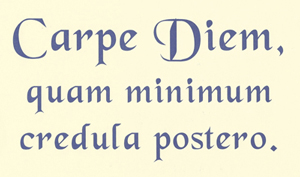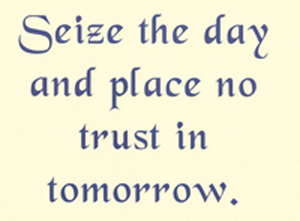"Enjoy the present moment and don't depend on there being a tomorrow." -Horace
A continuing traditional theme in lyric poetry, dating back at least to Koheleth's "Eat, drink, and be merry" (based on Ecclesiastes 8:15). The phrase carpe diem exemplifies the spirit of hedonism and Epicureanism, i.e., the enjoyment of the moment and recognition of the transient nature of life.
So, carpe diem came from ancient times until the present with the advice often and variously expressed as: "Enjoy yourself while you have the chance"; "Eat, drink, and be merry, for tomorrow we die"; "Make hay while the sun shines"; "Enjoy yourself, it's later than you think."
William Safire had a different attitude regarding carpe diem when he wrote: "Seize the day has come to mean ‘strike while the iron is hot.' No longer is carpe diem the what-the-hell attitude of the dwellers in the present; it has become the battle cry of the gutsy opportunist with an eye on the future."
Many famous poems develop this "live it up now" theme; such as , the following by Robert Herrick (1591-1674):
Old Time is still a-flying,
And this same flower that smiles today
Tomorrow will be dying.

Translation:

Motto of The University of the South, Sewanee, Tennessee, USA.
Also translated, "To be rather than to seem to be." State motto of North Carolina, USA; and a motto of the National College of Chiropractic, Lombard, Illinois, USA.
Motto of King Rudolf of Habsburg, Germany (1273-1291).
A modern version might be, "Don't try to cure or solve anything before it is necessary."
Motto of Otto I, "The Great" (936-973). The son of Henry I, Otto I was crowned king at Aachen, Germany, in 936 and received the imperial crown in Rome in 962. With this action, the Holy Roman Empire of the German Nation, regarded as the legitimate successor of the Roman Empire, was established.
In 955, he ended the Magyar menace with a victory at the battle of Lechfeld near Augsburg. He asserted his authority over the church of the country; German bishoprics everywhere were headed by bishops loyal to him. He is buried in the cathedral of Magdeburg, Germany.
